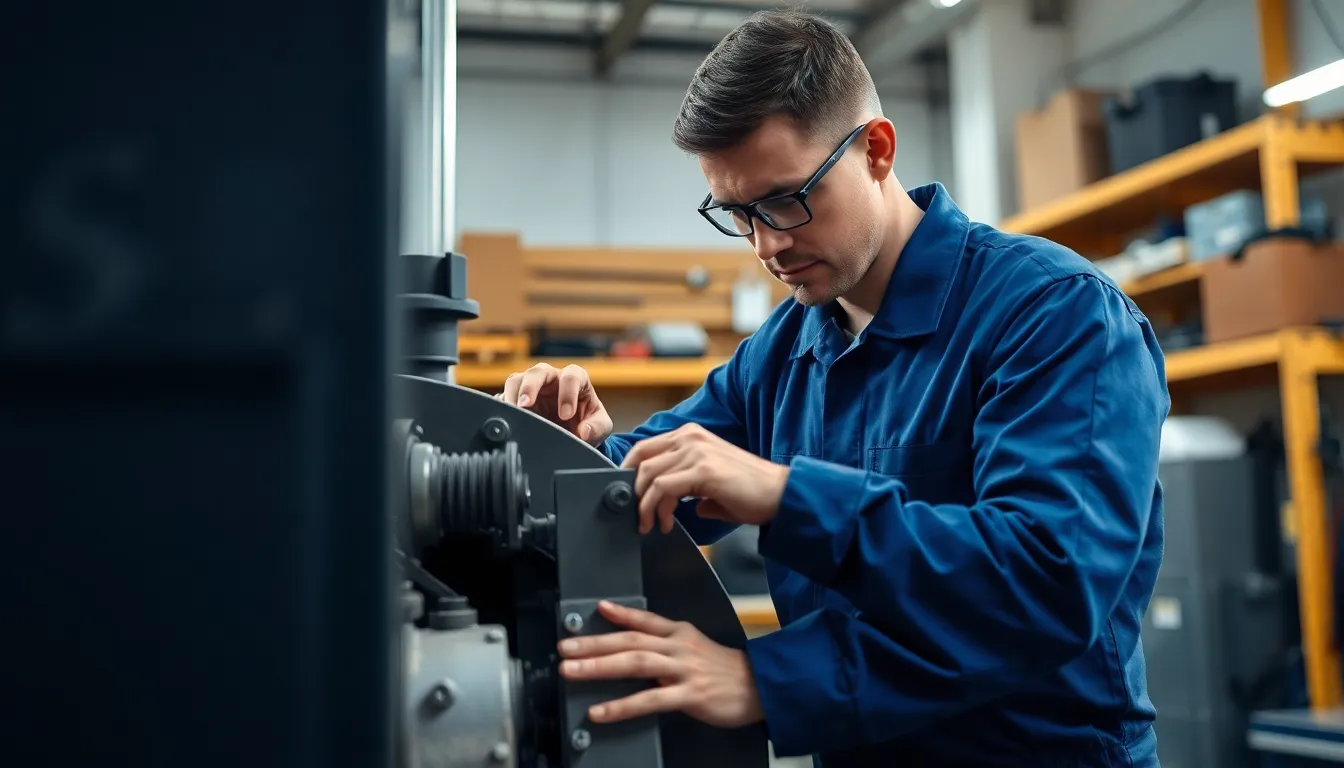In a world where machines can break down faster than a toddler’s tantrum, preventive maintenance tasks are the unsung heroes of the workplace. Think of them as the superhero capes for your equipment, swooping in to save the day before disaster strikes. By tackling these simple yet essential tasks, businesses can dodge costly repairs and keep operations running smoother than a well-oiled machine—literally.
Imagine a world where your equipment doesn’t throw a surprise party of malfunction right before a big deadline. With a little foresight and a dash of humor, preventive maintenance can transform chaos into calm. It’s not just about fixing what’s broken; it’s about ensuring it never breaks in the first place. So, buckle up and discover how these tasks can keep your business thriving and your stress levels low.
Table of Contents
ToggleUnderstanding Preventive Maintenance Tasks
Preventive maintenance tasks focus on identifying potential equipment issues before they escalate into major problems. This strategy emphasizes regular inspections, adjustments, and replacements to ensure all machinery operates efficiently. Scheduled tasks allow businesses to allocate resources more effectively, leading to reduced downtime.
Key activities within preventive maintenance include routine cleaning, lubrication, and performance testing. Each of these actions contributes to enhanced reliability and longevity of equipment. Technicians can spot wear and tear early, significantly lowering repair costs.
Data-driven insights support the effectiveness of preventive maintenance. Organizations that implement these tasks typically experience a 20 to 30 percent reduction in maintenance costs. This statistic highlights the financial benefits of adopting a proactive approach.
In addition to monetary savings, improved safety is another critical aspect. Regular checks help identify hazards, promoting a safer work environment. Furthermore, it fosters a culture of accountability among employees, emphasizing vigilance in equipment care.
Industry leaders often recommend developing a comprehensive maintenance schedule. This plan ensures all equipment receives timely attention, aligning with production goals. Integrating preventive maintenance into daily operations ultimately boosts productivity and morale.
Investing in training for personnel enhances the effectiveness of preventive maintenance tasks. Educated staff can perform simple maintenance checks, thereby minimizing reliance on outside technicians. Knowledgeable employees contribute to a more sustainable maintenance culture.
Together, these strategies form the backbone of an effective preventive maintenance program. Structured protocols not only protect assets but also support overall business efficiency.
Importance of Preventive Maintenance

Preventive maintenance tasks significantly enhance operational efficiency and safety. These practices play a crucial role in identifying potential equipment failures before they disrupt workflow.
Cost Savings
Implementing preventive maintenance leads to substantial cost savings. Organizations often see maintenance costs reduced by 20 to 30 percent when they adopt proactive strategies. Investing in routine inspections, timely repairs, and regular equipment checks prevents major breakdowns that incur hefty repair expenses. Reducing unscheduled downtime minimizes lost productivity, which directly impacts the bottom line. Allocating resources for preventive tasks often proves more economical than addressing emergencies and unexpected failures.
Equipment Longevity
Longevity of equipment relies on regular preventive maintenance. Routine checks, cleaning, and necessary adjustments contribute to the overall lifespan of machinery. Enhancing reliability through such tasks not only reduces repair frequency but also maximizes performance. Thorough maintenance schedules ensure that components remain in optimal condition, promoting durability. Moreover, trained personnel conducting checks increase awareness of potential issues, further extending machine life. Equipment that receives regular attention typically experiences fewer malfunctions, allowing for seamless operation and efficient production cycles.
Common Preventive Maintenance Tasks
Preventive maintenance encompasses various essential tasks aimed at keeping equipment in optimal condition. These tasks enhance operational efficiency and safety, contributing to a productive work environment.
Routine Inspections
Routine inspections identify potential issues early. Technicians examine equipment regularly, ensuring all components function correctly. Inspections include checking for wear and tear, monitoring performance metrics, and assessing safety features. Using a structured checklist promotes consistency and thoroughness during these evaluations. Organizations that conduct routine inspections can prevent unplanned downtime, improving overall workflow. Regular assessments also help meet compliance standards and maintain workplace safety. By prioritizing inspections, businesses benefit from extended equipment lifespan and reduced repair costs.
Cleaning and Lubrication
Cleaning and lubrication maintain equipment performance. Regular cleaning removes dust and debris that can cause overheating and mechanical failures. Keeping parts clean prevents corrosion and prolongs equipment life. Lubrication is vital for reducing friction between moving parts. Application of the right lubricant in appropriate amounts ensures smooth operation. Scheduling these tasks contributes significantly to reliability and efficiency. Preventive cleaning and lubrication not only enhance performance but also minimize the risks of breakdowns. By implementing these practices, organizations realize substantial cost savings and promote a proactive maintenance culture.
Developing a Preventive Maintenance Plan
Creating an effective preventive maintenance plan involves careful planning and execution to optimize operations.
Scheduling Tasks
Establishing a clear schedule for maintenance tasks ensures all equipment receives timely attention. Prioritization of tasks enhances efficiency and aligns with production goals. Categorizing tasks as daily, weekly, or monthly helps maintain focus. For example, daily tasks may include inspections, while monthly tasks could involve lubrication or filter changes. Using digital tools enables automation of scheduling reminders, helping teams stay organized. Setting specific timelines allows personnel to prepare resources in advance, fostering smoother execution.
Tracking Progress
Monitoring and documenting maintenance activities prove essential for improvement. Tracking progress ensures all scheduled tasks are completed on time, maintaining accountability. Regularly reviewing logs provides insights into patterns and recurring issues. Utilizing maintenance management software can streamline this process by generating reports on task completion rates. This data-driven approach helps identify areas needing attention, improving decision-making. Engaging team members in tracking fosters collaboration and enhances awareness of potential equipment issues.
Tools and Resources for Effective Maintenance
Effective maintenance relies on various tools and resources. Digital maintenance management software simplifies scheduling and documentation of preventive tasks. Such tools track service histories, generate maintenance reminders, and provide insights into recurring issues.
Equipment manuals serve as essential references. They offer specific guidelines for maintenance tasks, ensuring compliance with manufacturer recommendations. Each team member must understand how to access and interpret these manuals to perform tasks accurately.
Regular training sessions enhance staff competency. Equipped personnel can conduct inspections, perform cleanings, and make adjustments efficiently. Investing in workforce education reduces oversight and promotes proactive problem identification.
Measurement tools play a significant role in performance testing. Precision instruments, like digital calipers and torque wrenches, ensure equipment operates within specified parameters. Consistent use of these tools helps detect early signs of wear or malfunction.
Inventory management systems assist teams in maintaining necessary supplies. Tracking parts and lubricants ensures availability for seamless execution of preventive tasks. Stock management directly impacts the efficiency of scheduled maintenance activities.
Checklists streamline the inspection process. Custom lists tailored to each piece of equipment guide staff through essential tasks. Utilizing these tools increases accountability and reduces the likelihood of missed steps.
Communication platforms facilitate collaboration. Teams share updates on maintenance activities and report issues in real-time. Such systems foster transparency and enhance organizational awareness of equipment statuses.
Utilizing these tools and resources strengthens preventive maintenance outcomes. Prioritizing the right instruments fosters a proactive culture, minimizing downtime and extending equipment life.
Embracing preventive maintenance tasks is essential for any organization aiming to enhance operational efficiency and safety. By proactively addressing potential equipment issues, businesses can significantly reduce maintenance costs and minimize unplanned downtime. This strategic approach not only extends the life of equipment but also fosters a culture of reliability and accountability among staff.
Implementing a comprehensive maintenance plan backed by the right tools and resources ensures that teams stay organized and informed. Regular training and engagement in maintenance activities empower employees to contribute to a sustainable maintenance culture. Ultimately, prioritizing preventive maintenance lays the foundation for a thriving work environment where productivity and safety go hand in hand.








